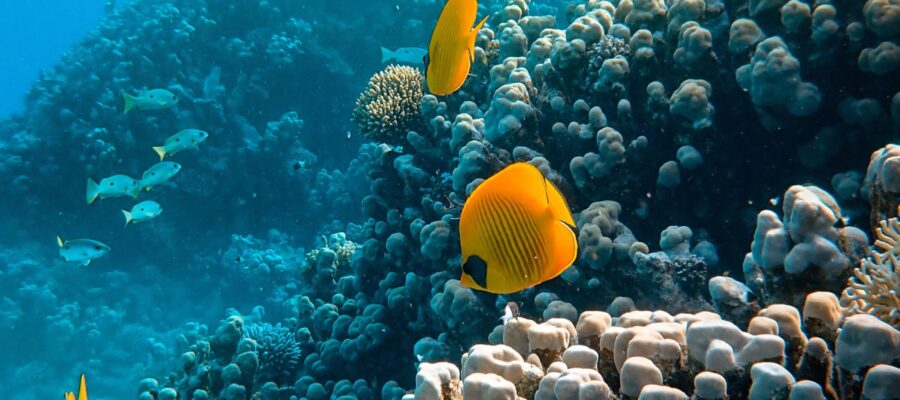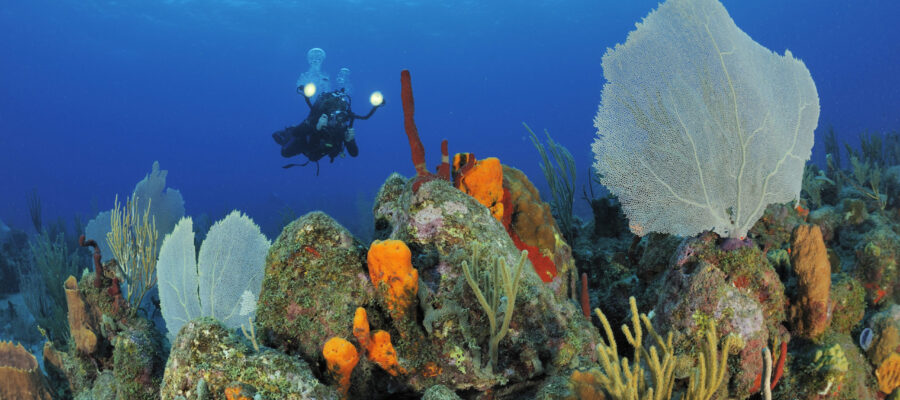© Good Travel Guide, October 2020
There are many attractive diving sites around the world. Among them are a couple of sustainable destinations: Bonaire and Sint Eustatius in the Caribbean, Douglas Shire along Australia’s Great Barrier and Chumbe Island Coral Park along the East Coast of Africa. Tourists make a beeline for diving trips to see the vibrant colours, astonishing coral formations, and diversity of marine life.
Unfortunately, coral reefs are at high risk because of climate change and intensive exposure to diving tourism. As a habitat for a multitude of marine life, coral reefs are integral to the health, well-being and existence of many species. This article highlights these two stressors that endanger the health of coral reef ecosystems; then suggests some tips to mitigate ruining reefs while we are in diving sites.
Climate change
The increase of average global temperature causes the warming of seas and oceans, which poses a major threat to coral reefs. One scientist in the Netflix documentary Chasing Coral
[efn_note]Netflix documentary. (2020). Chasing Coral. Available on YouTube.[/efn_note]
explains bleaching is like a fever for humans; it is a symptom of severe illness. In the last decade, outbreaks of mass bleaching and infectious diseases have increased dramatically
[efn_note]Michon Scott and Rebecca Lindsey. (2018). Unprecedented 3 years of global coral bleaching, 2014–2017. Available here.[/efn_note]
. Coral bleaching is the process of coral losing its colour and turning white. The vibrant colours of corals come from pigmented microscopic algae that lives on coral skeletons. Bleaching is a result of algae being expelled due to changes in the ocean environment, such as exposure to high temperatures and elevated levels of pollution. Bleaching leaves coral more vulnerable to disease and infection.
Bleaching rapidly accelerated in the early 1980s and by 1987 a severe mass bleaching was observed in many sites around the globe. Since then, global mass bleaching incidents have become even more common. In the 1972 UNESCO World Heritage Convention
[efn_note]See the report Impacts of Climate Change on World Heritage Coral Reefs: A First Global Scientific Assessment. Available here.[/efn_note]
It was observed that 23 out of 29 registered coral reefs were affected by climate change, and almost all of have turned white
[efn_note]Morrison, T.H., Adger, N., Barnett, J., Brown, K., Possingham, H. and Hughes, T. (2020). Advancing coral reef governance into the Anthropocene. One Earth, 2(1), pp.64-74.[/efn_note]
. In the last 30 years, 50% of coral reefs were damaged around the world due to the impacts of global warming
[efn_note]Netflix documentary. Op.cit.[/efn_note]
.

However, there is some hope. Certain coral reefs display higher resilience to the impacts of climate change. During the most recent global mass bleaching incident from 2014-2017
[efn_note]Eakin, C.M., Sweatman, H.P.A. & Brainard, R.E. (2019). The 2014–2017 global-scale coral bleaching event: insights and impacts. Coral Reefs. 38, 539–545.[/efn_note]
, coral reefs in the Red Sea were reported to have little to no bleaching at all. In an area of relatively higher water temperatures and salinity, there is substantial evidence that the coral reefs in the Red Sea have better capacity to adapt to climate change
[efn_note]Maha Khalil. (February 5, 2017). Coral Reefs of the Red Sea – Hanging In There! Available here.[/efn_note]
.
A coral reef can rebuild and recolour itself in 9 and 12 years in balanced and healthy conditions, without extreme weather disturbances such as cyclones
[efn_note]James Cook University. (February 20, 2019). How long does it take coral reefs to recover from bleaching? Available here.[/efn_note]
. However, these conditions are not guaranteed, especially as climate change is also expected to cause more frequent and intense weather disturbances
[efn_note]Centre for Climate and Energy Solutions. Extreme Weather and Climate Change. Available here.[/efn_note]
. So coral reefs are still at high risk from bleaching.
As well as rising temperatures, increased economic and urban development along coastal areas also poses a threat to coral reefs. Discharge from agricultural lands, untreated sewage water, and landfill waste leaks can seep into the water which dramatically alter the chemical balance of the seas. This further contributes to coral reef degradation. Unfortunately, even diving tourism is also be a primary factor to coral reef damage as seen in many diving sites in Egypt
[efn_note]Hanafy, M. (2012). Effects of recreational scuba diving and snorkeling on coral reefs of the sheltered bays of the Red Sea, Egypt. Egyptian Journal of Aquatic Biology and Fisheries, 16(4), 43-56.[/efn_note]
.
Divers’ activities
Snorkelling and scuba diving have been documented to cause coral breakage with sediment smothering the coral. Although the damage may not be noticeable from a single diving trip, the cumulative impact of daily repeated exposure can speed up the deterioration of coral reefs[efn_note]Barker, N. H. (2003). Ecological and socio-economic impacts of dive and snorkel tourism in St. Lucia, West Indies (Doctoral dissertation, University of York). Zainal Abidin, S. Z., & Mohamed, B. (2014). A Review of SCUBA Diving Impacts and Implication for Coral Reefs Conservation and Tourism Management. SHS Web of Conferences, 12, 01093.[/efn_note].
Diver-induced damage is usually caused by accidental physical contact with the reef. This contact comes from fins moving across the reefs and insecure falling on the coral. However, in popular tourist spots like the Maldives and Thailand, many tourists have also been known to walk over corals in shallow water. These destructive behaviours easily break the skeleton or damage the tissue of already fragile coral. Some studies show that divers with a camera can cause more damage than those without. Setting up a camera to shoot pictures of coral reefs has a higher risk of contact with the coral. Also, there is a higher risk of damaging coral when diving at night as divers often come closer to the reefs when observing them[efn_note]Barker, N. H. (2003). Op.Cit.[/efn_note].
Aside from physical damages, divers and snorkelers are also prone to stirring sediment with their fins. This can smother corals and adversely affect their normal functions[efn_note]Zainal Abidin, S. Z., & Mohamed, B. (2014). Op.Cit.[/efn_note].
Coral breakage and sediment smothering make the coral more susceptible to disease, reducing their ability to grow and recover
[efn_note]Guzner, B., Novplansky, A., Shalit, O., & Chadwick, N. E. (2010). Indirect impacts of recreational scuba diving: Patterns of growth and predation in branching stony corals. Bulletin of Marine Science, 86(3), 727–742.[/efn_note]
.

This kind of malpractice comes from lack of proper training from diving instructors or from those who hire out equipment. In some cases, the instructors are not fully trained; in other cases snorkelers do not properly follow the guidance they are given[efn_note]Barker, N. H. (2003). Op.Cit.[/efn_note].
That is why you should look for a dive school that understands the impact they are making and works with divers to help them behave responsibly. One such school in Bonaire, VIP Diving, is committed and checked and certified by independent auditors and ecolabel programs: Bonaire Blue Destinations and Good Travel Seal
Other than the behaviour of divers, tourist boats destroy coral by dropping their anchors over the reefs. This happens frequently in the Red Sea, many boats fasten anchors to reefs which can cause significant damage to the reef
[efn_note]See Hepeca activity ‘Mooring’. Available Sunscreen and Corals. Available here.[/efn_note]
. In fact, some diving destinations have already implemented a ban on using sunscreens with these specific ingredients
[efn_note]Shannon McMahon. (August 20, 2019). 6 Destinations with Sunscreen Bans, and What You Need to Know. Available here.[/efn_note]
.
The tourist industry has without a doubt contributed to the damaging of coral reefs. Much of this behaviour has come from negligence and a lack of adequate training. This as well as the impact of climate change is rapidly affecting the marine landscape”.
Solutions and recommendations
If you want to enjoy the beauty of the coral reefs without damaging local marine life, here are some websites which include tips for responsible diving:
- Choose a certified dive center as they will have more expertise in guiding you to dive responsibly and sustainably. It is highly recommended for dive centers to get certified by a trusted program, such as the Good Travel Seal.
- The website of Netflix documentary “Chasing Coral” has a section ‘take action’ which suggests many ways to contribute to reducing reefs bleaching.
- Green Fins offers free-downloadable guide manuals for professional divers as well as simple guide posters for the related diving activities.
- Wild Coast provides tips and instructions for snorkelers.
- The Australian Government, where are located the most attractive diving destinations, highlights some tips that divers should consider.
- HEPCA website offers different ways of engagement in conserving the Red Sea. One of them is to report any violation seen by tourists.




